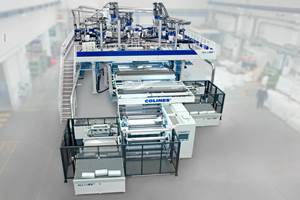NPE2018 New Technology Focus: All-Electrics Multiply in Blow Molding
All-electric shuttles and injection-blow machines continue to proliferate.
All-electric machines continue to make inroads in blow molding, as indicated by several new models on display. In Booth W2127, Bekum is introducing the electric EBlow 407DL (double-sided, long-stroke) shuttle machine, shown with a multi-layer, spiral-mandrel extrusion head, special quick-mold-change upgrade (15 min without tools), and a very compact layout. This U.S.-built machine has the company’s patented C-frame clamp (22.4 tons), max. mold width of 860 mm, max. mold length of 470 mm, mold depth of 2 × 130 mm, and open daylight of 250 mm.
Kautex Machines (Booth W1543) is molding three-layer personal-care bottles on a KBB40D double-side shuttle, one of its latest series of all-electric machines. This unit has been sold to Amcor, which has representatives at the Kautex booth.
Milacron exhibits one of the third generation of its all-electric shuttle machines in the booth of its representative, FGH Systems (Booth W3631). From this M-Series, introduced in late 2016, FGH has the M12.52ED, a double-sided press with 12-metric-ton clamp, and 520-mm shuttle stroke. At the show it is producing 14-oz personal-care bottles in eight cavities. FGH designed and built the mold and conversion package to accept existing “blow-and-drop” molds for in-machine deflashing using an adapter plate, new transfer arms, and deflashing punches.
Hesta of Germany is showing off its newest and largest all-electric shuttle, the double-station Hesta900 (Booth W2343). It has a 900-mm mold stroke, opening stroke of 240 mm, and 44-ton clamp. Dry-cycle time is 3.3 sec. It can handle up to 16 cavities per side and makes containers up to 5 L (10 L optional). Jackson Machinery (Booth W2149) is a representative for Hesta in the U.S. and Canada.
Electric servo drives are also penetrating injection-blow molding. Pet All Manufacturing in Canada (Booth W6545) has brought one of its new range of CanMold injection-blow machines, an all-electric IBM 300/700. Besides “huge” energy savings, it is said to be faster than hydraulic models and is suited to clean rooms. This 88-ton, three-station machine is aimed at small containers (typically 2 oz to 1 L) for pharmaceuticals and cosmetics with very high neck tolerances.
Milacron is exhibiting in its own booth (Booth W2703) a Uniloy IBS 85 (81 tons) injection-blow system that is available in electric, hydraulic, and hybrid versions. The news here is that this machine is equipped to mold three-layer barrier containers, using Milacron’s Kortec hot-runner co-injection technology. The machine uses a Mold-Masters E-Multi electric servo-driven secondary injection unit to deliver the barrier layer. The IBS 85 will mold a 7.5-g, four-cavity pill bottle in a 12-sec cycle.
Jomar Corp., which has experimented with all-electric drive in the past, has concluded that most cost-effective energy-saving option is its IntelliDrive Series with a servo-hydraulic pump and variable-frequency drive. Jomar (Booth S12077) is running the IntelliDrive Model 85S (72 tons) that was first introduced at K 2016, but the IntelliDrive system has been extended to its two largest machines, 135 and 175 tons—in fact, the conventional hydraulic version of the Model 175 has been discontinued. Intellidrive machines reportedly save up to 50% in energy consumption and use 40% less tower water, at only 10-15% higher cost than standard IBM presses. Jomar also has upgraded the clamp with a closed-loop system that shortens dry-cycle times.
Related Content
In Sustainable Packaging, the Word is ‘Monomaterial’
In both flexible and rigid packaging, the trend is to replace multimaterial laminates, coextrusions and “composites” with single-material structures, usually based on PE or PP. Nonpackaging applications are following suit.
Read MoreFormulating LLDPE/LDPE Blends For Abuse–Resistant Blown Film
A new study shows how the type and amount of LDPE in blends with LLDPE affect the processing and strength/toughness properties of blown film. Data are shown for both LDPE-rich and LLDPE-rich blends.
Read MoreAutomotive Awards Highlight ‘Firsts,’ Emerging Technologies
Annual SPE event recognizes sustainability as a major theme.
Read MoreYoung Stretch-Film Processor Bets on Nanolayers
Going up against companies with as much as double its capacity, young stretch-film processor Zummit believes that new technology — notably 59-nanolayer films — will give it a competitive edge.
Read MoreRead Next
Why (and What) You Need to Dry
Other than polyolefins, almost every other polymer exhibits some level of polarity and therefore can absorb a certain amount of moisture from the atmosphere. Here’s a look at some of these materials, and what needs to be done to dry them.
Read MorePeople 4.0 – How to Get Buy-In from Your Staff for Industry 4.0 Systems
Implementing a production monitoring system as the foundation of a ‘smart factory’ is about integrating people with new technology as much as it is about integrating machines and computers. Here are tips from a company that has gone through the process.
Read More







.png;maxWidth=300;quality=90)
















